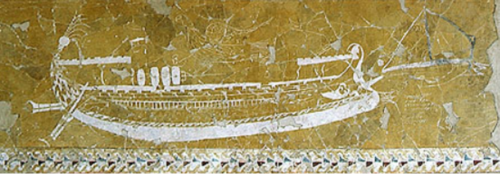The ArgoFram is the new light expedition inflatable boat (eRIB) that will take Daniel around Europe and bring him back safely. – How did it get its name? And why did it get its name?
The Argo was the most developed ship and more than ahead of its time: She was stylishly constructed (approx. 35 m long and 4 m wide) and could carry around 90 people; she was fabulously fast – powered by 50 heroes! – and equipped with a rectangular sail. It was made of pine trees, and reinforced at the bow with prophesying oaks, which were even better than today’s best radar and satellite reconnaissance systems in predicting (!) what obstacles and dangers the crew would encounter – and that about 1,200 years before Christ.
Model of a Pentekontere (‘fifty rudder’), an antique ship type with optional sail
The builder of the Argo was Argos, one of the travelling heroes; Athena is mentioned as the ship’s engineer, and Hera is also said to have played a part as patron saint. – If you want to read again where these world explorers ventured with the Argo and what adventures they faced, here is the story of the Argonauts.
The Fram was the first ship to sail in the Arctic Ocean and the Southern Ocean, taking the Norwegian adventure explorers Fridtjof Nansen, Otto Sverdrup and Roald Amundsen safely through the waves and ice masses. The Fram was constructed by Colin Archer in 1892 in such a way that it could drift in the pack ice without being damaged by the enormous pressure of the ice (the Fram was designed in such a way that it was not crushed by the surrounding ice masses, but lifted – and thus ‘stood’ on the pack ice). To protect it from the ice, even the rudder and propeller drive could be retracted. In addition, the frame was thermally insulated, so that even in icy temperatures during the six months of ice drift (during which it was trapped in the ice), no one was damaged.
The Fram trapped in the northern pack ice (1894)
The Fram is said to have been very difficult to sail, but also had a triple expansion steam engine. For Amundsen’s South Pole expedition in 1910, she was fitted with a diesel engine – the first of its kind in the world for a seagoing vessel; it was capable of 180 hp and could be turned to reverse.
The Fram in the drift ice of the Southern Polar region (1912)
Like the Argo, the Fram had a length of about 35 m, but was almost three times as wide (11 m) – it was designed for a crew of 16 men and was used for expeditions until 1914. It can still be admired today in the Fram Museum near Oslo.
Here you can find out more about the polar explorers Fridtjof Nansen, Otto Sverdrup and Roald Amundsen and the constructor of the Fram, Colin Archer.
Well, aren’t we reaching too high to name an almost 10 m long inflatable boat after these two models? – Our ArgoFram is neither a high-tech boat nor built for extreme conditions; no gods have been involved, no heroes are at the helm! – The ArgoFram wants to be nothing more than a practical expedition inflatable boat, formed from concrete requirements (Daniel) and years of experience (Marko), created from solid craftsmanship, equipped with simple but proven technology, agile and fuel-efficient, but no more than a smooth-running ‘touring bike’ that Daniel is supposed to carry safely around Europe.
The reason for the name is based on the stories linked to the Argo and the Fram, which have survived for generations and continue to inspire and motivate us humans today – it is these stories that ultimately led to this project and inspired Daniel to explore Europe by water.
ArgoFram is therefore a tribute to those ‘heroes’ who were not discouraged by couch potatoes, but rather boldly explored new territory, and a tribute to those boatbuilders who put their keen minds on the water in many well thought-out construction plans, trusting that their ships would hold what they were built for. So the name also includes the wish that this inflatable boat will allow Daniel to feel the elements up close and to land anywhere, but also to return him safely.
The ArgoFram is a joint effort and extraordinary in many ways; we will care for it, but we will also push it to its limits. At times it will have to hold up to 1’000 litres of fuel (because there will be no petrol stations along the way; the Barents Sea is not necessarily known as a cozy pond, and in the far north or in the White Sea Daniel will be without radio contact for several weeks and will not find any man-made landing sites). – We know: A ship is safe in port but it is not made for ports.
-
About the creation of the ArgoFram
-
First test drives
-
The maiden voyage


